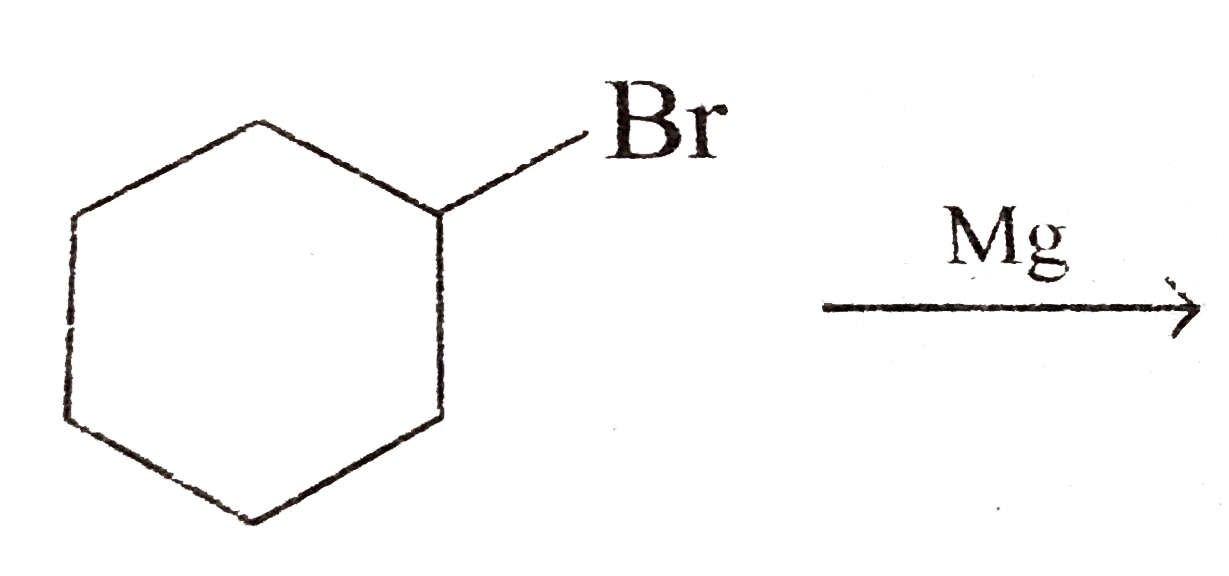In the reaction sequence Cyclohexane
hv/Cl2−−−→(A)alk.KOH/Δ−−−−−−−−→(B)(i)O3−−−−−−−−−→(ii)Zn/H2O. 'C' will be
Hexanal
2-Hexanone
3-Hexanone
Hexane-1,6-dial
The correct Answer is:D
To solve the problem step by step, we will analyze the reaction sequence provided in the question.
Step 1: Chlorination of Cyclohexane
The first step involves the chlorination of cyclohexane (C6H12) using chlorine gas (Cl2) in the presence of light (hv). This reaction will replace one of the hydrogen atoms in cyclohexane with a chlorine atom, resulting in the formation of chlorocyclohexane (A).
Chemical Reaction:
Cyclohexanehv,Cl2−−−−→Chlorocyclohexane (A)
Step 2: Elimination Reaction with Alcoholic KOH
Next, the chlorocyclohexane (A) is treated with alcoholic KOH and heated. This reaction leads to a beta-elimination process, where the chlorine atom is removed along with a hydrogen atom from a beta position, forming a double bond. The product of this reaction is cyclohexene (B).
Chemical Reaction:
Chlorocyclohexane (A)alc. KOH, heat−−−−−−−−−→Cyclohexene (B)
Step 3: Ozonolysis of Cyclohexene
The cyclohexene (B) is then subjected to ozonolysis, which involves the reaction with ozone (O3). In this step, the double bond in cyclohexene is cleaved, and oxygen atoms are added to the resulting fragments.
Chemical Reaction:
Cyclohexene (B)O3−→Ozonide
Step 4: Reductive Workup with Zn and H2O
Finally, the ozonide is treated with zinc (Zn) and water (H2O), which leads to the reductive ozonolysis. This process will convert the ozonide into aldehydes. In this case, we will end up with two aldehyde groups at the ends of the carbon chain.
Chemical Reaction:
OzonideZn,H2O−−−−−→Hexanedial (C)
Final Product (C)
The final product (C) is hexanedial, which has two aldehyde groups at the first and sixth positions of the hexane chain.
Summary of the Reaction Sequence
1. Cyclohexane is chlorinated to form chlorocyclohexane (A).
2. Chlorocyclohexane undergoes elimination to form cyclohexene (B).
3. Cyclohexene is ozonized to form an ozonide.
4. The ozonide is reduced to form hexanedial (C).
Answer
C will be hexanedial.
The first step involves the chlorination of cyclohexane (C6H12) using chlorine gas (Cl2) in the presence of light (hv). This reaction will replace one of the hydrogen atoms in cyclohexane with a chlorine atom, resulting in the formation of chlorocyclohexane (A).
Cyclohexanehv,Cl2−−−−→Chlorocyclohexane (A)
Next, the chlorocyclohexane (A) is treated with alcoholic KOH and heated. This reaction leads to a beta-elimination process, where the chlorine atom is removed along with a hydrogen atom from a beta position, forming a double bond. The product of this reaction is cyclohexene (B).
Chlorocyclohexane (A)alc. KOH, heat−−−−−−−−−→Cyclohexene (B)
The cyclohexene (B) is then subjected to ozonolysis, which involves the reaction with ozone (O3). In this step, the double bond in cyclohexene is cleaved, and oxygen atoms are added to the resulting fragments.
Cyclohexene (B)O3−→Ozonide
Finally, the ozonide is treated with zinc (Zn) and water (H2O), which leads to the reductive ozonolysis. This process will convert the ozonide into aldehydes. In this case, we will end up with two aldehyde groups at the ends of the carbon chain.
OzonideZn,H2O−−−−−→Hexanedial (C)
The final product (C) is hexanedial, which has two aldehyde groups at the first and sixth positions of the hexane chain.
1. Cyclohexane is chlorinated to form chlorocyclohexane (A).
2. Chlorocyclohexane undergoes elimination to form cyclohexene (B).
3. Cyclohexene is ozonized to form an ozonide.
4. The ozonide is reduced to form hexanedial (C).
C will be hexanedial.
Topper's Solved these Questions
Similar Questions
Knowledge Check
In the following sequence of reactions, identify the final product. Cyclopentance Cl2/hv−−−→(I)alc.KOH,Δ−−−−−−−→(II)(i)O3−−−→(III)
ApentanalBpentane -2- oneCpentan -3-oneDpentane -1,3,-dialSuccinic acid Δ−−→(A)NH3−−−−−→Δ(B)Br2−−−−−→KOH(C), Product (C) will be :
ACH2−CO2H|CH2−CH2−NH2BCH2−CO2H|CH2−NH2CCH2−CO−2K+|CH2−NH2DCH2−CO2H|CH2−CH2−Br Mg−−→(A)(i)14CO2−−−−−−−−→(ii)H+/H2O(B)NaHCO3−−−−−→(C) gas, product C is :ACOB.14CO2CCO2DA mixture .14CO2 and CO2
Mg−−→(A)(i)14CO2−−−−−−−−→(ii)H+/H2O(B)NaHCO3−−−−−→(C) gas, product C is :ACOB.14CO2CCO2DA mixture .14CO2 and CO2

O3(1mole)−−−−−−−−−→Zn(A)Conc.KOH−−−−−−→
(B) H+−−−−−→Δ(C ), Product (C ) is
View SolutionThe compound (A) in the following reaction sequence is
(A)PCl5−−→ (B) Alc.KOH−−−−→ (C )H2/Ni−−−→ Propane.
View SolutionIn the reaction sequence :
C2H5OHPBr3−−→AKCN−−→BH2O+−−−→C
C is :
View SolutionThe compound (A) in the following reaction sequence is:
(A) PCl5−−→ (B) Alc KOH−−−−→ ( C) H2/Ni−−−→
Propane :
View SolutionIn the given reaction sequence
CH3CHO(i)NaCN/HCl−−−−−−−−−−−−→(ii)H2O+(A)Fenton−−−−−−→reagent(B), B will be
View Solution
